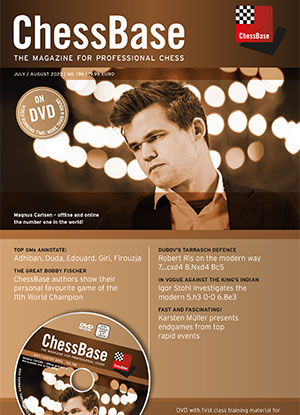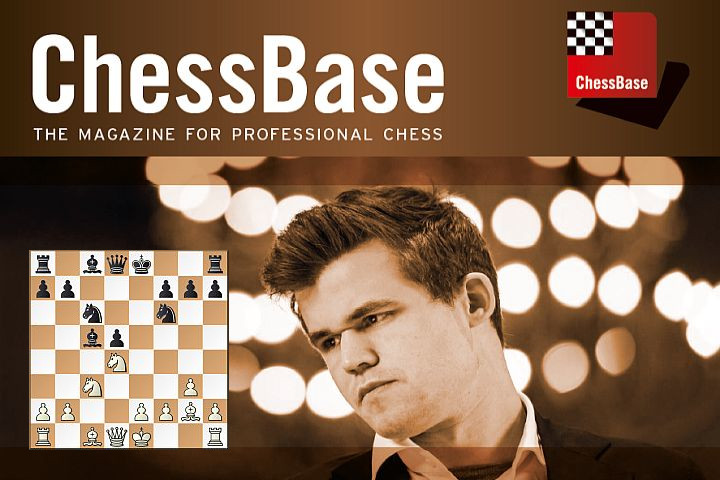Dubov's Tarrasch
Robert Ris examines the forcing 7...cxd4 8.Nxd4 Bc5
Our starting point arises after 1.d4 d5 2.c4 e6 3.Nf3 Nf6 4.Nc3 c5 5.cxd5 exd5 6.g3 Nc6 7.Bg2 cxd4 8.Nxd4 Bc5
The Tarrasch has recently been frequently tested at the top level, and basically one man is responsible for that: the young Russian Daniil Dubov, second of World Champion Magnus Carlsen in his last title match with Fabiano Caruana, is a great theoretician and certainly a man to follow closely in the opening! Inspired by developments in correspondence and computer chess he has ensured that an old and forgotten line of the Tarrasch (7...cxd4 8.Nxd4 Bc5) is currently the centre of debate again.
Interestingly, following the key games from this article, you will notice that the move order chosen there and stated above, reaching the position in the diagram, is not the classical Tarrasch move order (1.d4 d5 2.c4 e6 3.Nc3 c5 4.cxd5 exd5 5.Nf3 Nc6). As Peter Heine Nielsen mentioned, 6.Bg5!? is in fact the critical continuation (White hasn't decide to fianchetto his king's bishop yet), though it remains to be seen how problematic that is for Black. After all, Magnus himself allowed this move order twice in 2019 (replying 6...Be6 in both cases).
The good news for Tarrasch players is that the position can be reached from other different move orders as well (English, Reti etc.), which makes the content discussed in this article a very attractive choice to build a simple repertoire against 1.d4/1.c4 and 1.Nf3 all at the same time.
Now, White has to decide whether to play against hanging pawns (Variation A) or the isolated d-pawn (Variation B).
A) 9.Nxc6 bxc6 10.0-0 0-0
A very classical type of position. Compared with the lines examined in Variation B, Black doesn't have to worry about his pawn on d5 which is well protected.
A1) Interestingly, the move 11.Bg5, as played in Duda,J - Dubov,D ½-½, initiates a tactical intermezzo. In that game there followed 11...h6 12.Bxf6 Qxf6 and now White has the interesting temporary piece sacrifice 13.Nxd5!?
leading to massive simplifications. With precise play I believe Black should be able to hold, but for those who are looking for a real fight I imagine these prospects aren't very attractive. Instead, the calm developing 11...Re8!? leads to a perfectly playable game for Black.
A2) Setup with Qc2 & Na4
Since line A1) doesn't bring White an advantage, he has been recommended to go for a slower approach. Various moves have been tried here, and very possibly one line transposes into another. The main line runs 11.Qc2 Bb6 12.Na4 Bd7 13.b3 Re8 14.Bb2 h5!?.
As so often in this article, the h-pawn plays an important role in Black's concept. I find the insights of Peter Heine Nielsen on the game Aronian,L - Carlsen,M 0-1 very instructive and sufficient to make me feel an understanding of how to handle this type of pawn structure. Just out of curiosity I delved a bit deeper into the position and analysed the game Rodshtein,M - Dubov,D 0-1 in detail. All in all, I believe Black hasn't much to fear in the ensuing positions with hanging pawns.
B) 9.Nb3
With his last move White gains a tempo on the bishop and is ready to play against the isolated pawn. Since, 9...Bb4?! doesn't give Black great prospects at all, the critical continuation is 9...Bb6!?. For a long time this move had never been taken seriously, but recently it has been discovered that Black obtains excellent play if White captures the pawn.
B1) 10.Nxd5 Be6!
In my opinion the most precise way for Black to proceed. In the annotations of the game Raahul,V - Tukhaev,A ½-½ it becomes clear that Black doesn't have too many difficulties equalising.
B2) 10.Na4
This has rarely been tried, but deserves serious attention. After 10...0-0 11.Nxb6 axb6 12.Be3 an interesting position has been reached.
White possesses the bishop pair and a better pawn structure, so why could this ever be OK for Black? Black's has more space and his pieces are quite active, as for instance the rook on a8 already exerts pressure down the a-file. More importantly, Black is looking for ways of building up the pressure on the other wing. In Mamedyarov,S - Dubov,D ½-½, the very interesting move 12...h5!? was tried. I very much like Dubov's play in this game, as White was never allowed to stabilise the situation in the centre and start a grind, exploiting his positional assets. Also 12...Re8, as played in a computer game, very nicely illustrates Black's dynamic potential.
B3) 10.0-0 d4 11.Na4 0-0 12.Bg5 Re8
The main tabiya of this article. Before chasing the bishop away with ...h7-h6, Black activates his king's rook by pressurising the pawn on e2.
B31) 13.Nxb6 axb6 14.e3
The solid 14...dxe3?! just leads to a slightly inferior middlegame, without any prospects to complicate matters, though in a computer game Black managed to hold. Not particularly according to Dubov's style! More ambitious is 14...d3!? 15.Bxf6 gxf6
which was seen in the game Nakamura,H - Dubov,D ½-½. Black's pawn structure is awful, but how should White exploit that? In fact, it's all about the far advanced pawn on d3 which is well supported by Black's pieces and prevents White from activating the pieces. It seems to me that Black is doing alright.
B32) 13.Re1 h6 14.Nxb6 axb6 15.Bxc6 bxc6 16.Bxf6 Qxf6 17.Qxd4 Qd8!.
After a long forcing sequence, Black with his last move aims at trading off queens under favourable circumstances, not allowing the white knight to become active. In order to fight for an advantage, White must keep queens on the board, but in correspondence play Black has proven to have reasonable compensation for the missing pawn. The light squares around the white king are vulnerable (absence of Bg2) and Black's major pieces are more active than their counterparts. In the high-profile blitz game Carlsen,M - Dubov,D 1-0 , the game abruptly ended after a miscalculation from the Russian star. However, in my annotations you find some improvements for Black which seem to make this variation playable for Black.
Conclusion: The Dubov Variation of the Tarrasch is very hot at the moment and deservedly so. While in the variations the engines mostly are claiming a slight advantage for White, it's fascinating to see how Black all the time succeeds in generating active counterplay, either on the queen- or kingside. In my opinion line B32) is the critical test of Black's setup and I'm expecting more games to be seen in the near future. The ensuing positions are indeed perhaps slightly better for White objectively speaking, but in a practical game Black can certainly count on counterplay. So far, Dubov has managed to give several elite players a very hard time, so I don't think you have much to be afraid of playing this system with Black!
You'll find the complete article with all games and analyses in ChessBase Magazine #196 (July/August 2020).

Order now at the ChessBase Shop !
Single issue: 19,95 € – Annual subscription (6 issues): 99,70 €
Available for download (including booklet in pdf) or on DVD + booklet (Post).























